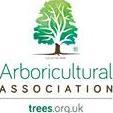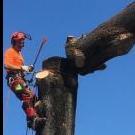.jpg.aaced0528656c8de464276aa6c002d79.jpg)
Article by Keith Sacre
Ian Shears is the Manager of Urban Sustainability at Melbourne City Council. He is speaking at the AA’s Conference in Exeter this year. While I was at the Arb Australia Conference in May I spent some time with Ian. He exudes energy and enthusiasm, and his excitement at what is being achieved in Melbourne is immediately obvious. Sitting the other side of a desk from him, it was easy to become engaged and engrossed in the Melbourne urban forest story. If that story translates as well to the podium at conference then we are all in for a very inspiring and informative treat.
 Ian and his team of 50 manage an urban forest of some 75,000 trees and all the publicly owned green spaces in Melbourne. The landscape is a real mixture of historic gardens lined with significant avenues of trees planted in the mid-to-late 1800s, public open spaces adorned with the usual mixture of inner-city facilities and street trees – some old, some newly planted and a mixture of everything in between. It is impossible to be in Melbourne for any length of time and not to realise how important green space and trees are to the city; they collectively contribute to the vibrancy and bustle of the place which has a population of 130,000 but has to provide an infrastructure capable of meeting the demands of over a million workers and tourists.
Ian and his team of 50 manage an urban forest of some 75,000 trees and all the publicly owned green spaces in Melbourne. The landscape is a real mixture of historic gardens lined with significant avenues of trees planted in the mid-to-late 1800s, public open spaces adorned with the usual mixture of inner-city facilities and street trees – some old, some newly planted and a mixture of everything in between. It is impossible to be in Melbourne for any length of time and not to realise how important green space and trees are to the city; they collectively contribute to the vibrancy and bustle of the place which has a population of 130,000 but has to provide an infrastructure capable of meeting the demands of over a million workers and tourists.
Yet, as with all cities, there are pressures. Many of the significant avenues are reaching the end of their useful life with 23% of the tree population estimated to come to the end of its useful life within 10 years. This estimate rises to 39% within 20 years. The city has a significant elm population with several magnificent avenues. It is estimated that 55% of these trees are in a state of severe decline and will need to be removed from the landscape within the next ten years. Almost 43% of the tree population comes from one family, the Myrtaceae, which includes Eucalyptus, Corymbia, Callistemon, Angophora and Melaleuca, all of which are vulnerable to myrtle rust, which has been found in Melbourne. While there are some 388 different species within the boundaries of the city it is recognised that London plane represents 75% of the trees within the central area and that just three families represent 63% of the total population. While the numbers, percentages and species may vary, these and other problems will not be unfamiliar to urban forest managers in the UK and are international in their constant repetition.
What is unusual is the way Melbourne, through the inspiration of Ian Shears and his team, have set about addressing the situation and especially the problems associated with long-term urban forest management. The city has been extensively mapped for tree health, species composition, canopy cover and useful life expectancy. A limited i-Tree study of 982 trees in the city area provided an assessment of the ecosystem services being provided by the tree population and an estimate that the city’s trees have an amenity value of some 700million Australian dollars. Canopy cover has been assessed by precinct, with a variation between precincts of between just over 34% cover and less than 5%.
It is impossible to fully explain in this article all the elements which make Melbourne such an interesting case study and it would take a better reporter than me to record everything Ian enthused about during our time together. You will have to attend the conference for that, but here is a flavour of the elements which appeared significant to me.
 Strategy, planting, maintenance
Strategy, planting, maintenance
First, Melbourne plants some 3,300 trees each year. These are all contract grown, giving the city the opportunity to select the species it actually wants to enhance the resilience of the tree population as a whole and to control the specification of the trees supplied. The vagaries of the market-place are removed. This practice is not commonly followed in the UK where many municipalities are dependent on ‘what the nursery industry’ has available at the time of supply. Melbourne’s practice enables the city to plan in advance. All of its trees are planted under contract with a three-year maintenance programme associated with the planting contract. This is not so unusual, but the fact that the tree planting is independently audited at the end of the contract period with the condition of the young trees assessed before the city accepts ownership is a significant difference. Maybe something we can learn here? I was told a story, not confirmed, that the first such audit found that 46% of the young trees were in an unacceptable condition and that the contractor responsible had to make good before being sacked.
The city has a clear urban forest strategy plan with six defined targets. These are:
- increase canopy cover to 40% by 2040
- increase urban forest diversity
- improve vegetation health with 90% of Melbourne’s trees being healthy by 2040
- improve soil moisture and water quality
- improve urban ecology
- inform and consult the community
This strategy is firmly embedded within a well-defined city policy framework. But unlike many tree strategies which are just wish lists, the Melbourne plan appears to have real meaning and, more importantly, clout. So why should this be the case?
 Making the case
Making the case
It would appear that there is both serious political engagement and serious community engagement and buy-in to the programme. Again we come back to the communication skills, energy and enthusiasm of Ian Shears himself. He explained in some detail the amount of time he has spent engaging with politicians, canvassing and making the case for the urban forest and its importance to Melbourne. He showed a series of photographs which just happened to be taken of trees near to the areas where politicians lived. These trees were cleverly Photoshopped out, leaving the stark, naked, tree-free streets clearly visible and demonstrating the impact of ‘doing nothing’.
Ian than went on to describe, again in some detail, the amount of time, energy and effort he and his team have expended in speaking to community groups, residents’ associations and the like, again making the case for the urban forest and illustrating how important that forest actually is to the community and the many benefits residents gain from it. It is interesting to note that each of the precincts referred to earlier now has its own management plan composed of action points and priorities for urban forest development, constructed and put together under the guidance and support of Ian and his team.
As with all reports from foreign parts, the traveller, in this case me, can only take a snapshot and is largely reliant on stories told and limited personal observation. The detail is always veiled and partially camouflaged, but on this occasion, I have met Ian and members of his team, seen the impressive documentation, more importantly perhaps walked as much of Melbourne as it is possible to walk in just a few days, and observed, photographed and made just a few notes. My observations confirm much of what I had been told. The city is vibrant, the green spaces are well used, there is extensive tree planting, and management practices have been adapted to conserve some of the significant ageing avenues within the historic gardens – and incidentally, the botanic garden has a fine collection of trees.
Many of you will not be able to visit Melbourne yourselves but Ian Shears is speaking on ‘Transitioning Melbourne’s urban landscapes – climate change for future liveability’ at the Association’s Conference on 10–13 September.
I believe it would be worth coming to listen and have the opportunity to question him. His experience and initiatives offer a model from which we can all learn something.
-
 1
1
Report Article











Recommended Comments
There are no comments to display.
Create an account or sign in to comment
You need to be a member in order to leave a comment
Create an account
Sign up for a new account in our community. It's easy!
Register a new accountSign in
Already have an account? Sign in here.
Sign In Now